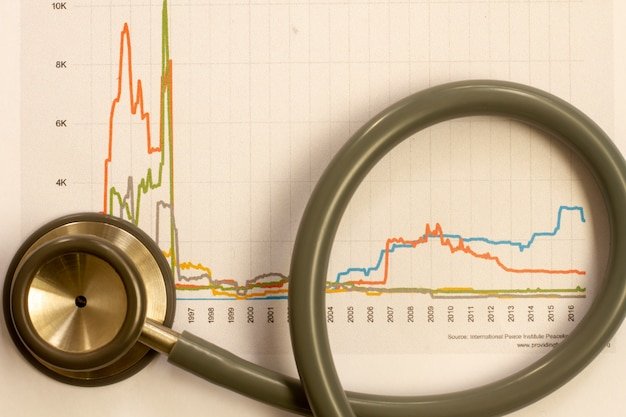Budgeting for Healthcare: A US Guide to Rising Costs in 2025

Budgeting for rising healthcare costs in 2025 requires a proactive approach, involving careful planning, understanding insurance options, and exploring strategies to mitigate expenses while ensuring access to necessary care in the United States.
The escalating cost of healthcare is a pressing concern for many Americans. As we look ahead to 2025, it’s crucial to develop effective **budgeting for rising healthcare costs**. This guide provides a US perspective on navigating these financial challenges.
Understanding the Healthcare Cost Landscape in 2025
To effectively budget, it’s essential to understand the factors driving healthcare costs. Several elements contribute to the increasing financial burden on individuals and families in the US.
Key Drivers of Rising Healthcare Costs
Several factors contribute to the relentless increase in healthcare expenses. We must understand their significance to mitigate their impact.
- Aging Population: An aging population requires more medical care. The demand for healthcare services increases as people live longer.
- Technological Advancements: Innovations in medical technology, such as advanced imaging and robotic surgery, come at a premium.
- Prescription Drug Prices: The cost of prescription medications, especially specialty drugs, continues to rise due to research and development expenses, market exclusivity, and regulatory policies.
- Administrative Overhead: The complexities of the US healthcare system lead to substantial administrative costs related to billing, insurance processing, and regulatory compliance.
These drivers create a challenging financial environment. Being aware of these dynamics helps households prepare accordingly.

Assessing Your Current Healthcare Spending
An assessment of your current situation is mandatory before crafting an efficient budget to prepare for the future of paying for healthcare expenses. Know your data.
Before making any budgetary modifications, take inventory of recurring expenses. This step helps create a useful foundation for a sound financial plan and helps people prepare practical strategies for the future.
Reviewing Past Medical Expenses
Gather medical bills, insurance statements, and pharmacy receipts from the previous year. You must gather all data to establish an accurate spending benchmark.
Categorize your healthcare expenses into the following:
- Doctor visits.
- Prescription medications.
- Dental care.
- Vision care.
- Emergency room visits.
- Hospital stays.
Analyzing Insurance Coverage
Understand the details of your health insurance plan, including:
- Premiums.
- Deductibles.
- Co-pays.
- Co-insurance.
- Out-of-pocket maximums.
Knowing these elements helps anticipate potential healthcare expenses and strategize effectively. By analyzing your healthcare spending and understanding your insurance plan, you can get a clear picture of your current financial situation. This information is crucial for making informed decisions about budgeting and planning for future healthcare costs.
Creating a Realistic Healthcare Budget
Now let’s explore how to accurately forecast medical expenses and develop an efficient plan. This is the moment to make projections about what the future could hold.
Budgeting tools and techniques are readily available. They will make the process go smoothly. Many options are available online or through financial planning software. Find the best option for your needs.
Estimating Future Medical Expenses
Use the previous year’s medical expenses as a starting point. Factor in possible cost increases, changes in health status, and potential medical needs.
Increase your estimated expenses by a conservative percentage. For example, you may add 5-10% to account for inflation and rising healthcare costs. Consider upcoming medical procedures or treatments you may need in 2025. This is the moment to act on what you may know is coming.

Setting Savings Goals
Determine how much you need to save each month to cover anticipated healthcare expenses. Break down your savings goal into smaller, manageable amounts.
Utilizing Budgeting Tools
- Spreadsheets: Creating a basic Excel spreadsheet allows you to track your income, expenses, and savings.
- Budgeting Apps: Several popular apps make it easier than ever to track your finances. Examples include Mint, YNAB (You Need a Budget), and Personal Capital.
- Professional Advice: Consider consulting a financial advisor who can provide personalized guidance on budgeting and financial planning.
Realistic budgets serve as a roadmap for financial stability. Make sure to be honest with your calculations and keep your spending habits in mind as well to make the most accurate budget.
Strategies to Reduce Healthcare Costs
It’s time to adopt proactive strategies that improve health outcomes and lower healthcare costs. Here is what to do:
Several practical approaches can help you manage and minimize healthcare expenses. Prevention is the key to saving money when managing healthcare costs.
Preventive Care and Wellness Programs
Take advantage of preventive care services covered by your insurance plan. These services include:
- Annual physicals.
- Vaccinations.
- Screenings.
Participate in wellness programs offered by your employer or insurance provider. These programs are designed to promote healthy living and detect health issues early. Stay active and be conscious of your health.
Comparing Medication Costs
Compare prescription drug prices at different pharmacies. Consider using generic medications, which are significantly cheaper than brand-name drugs.
Explore options such as mail-order pharmacies or discount drug programs. Also, evaluate whether you can use over-the-counter alternatives for certain medications. This practice is safe with conditions such as seasonal allergies or occasional heartburn.
Telehealth Services
Telehealth offers a convenient and cost-effective way to consult with healthcare professionals remotely. By utilizing telehealth services, you can avoid costs associated with in-person visits such as transportation. As technology advances, the role of remote checkups will become increasingly relevant.
Taking control of preventative practices reduces risks and lowers costs. Telehealth keeps you out of physical offices, saving you transportation and time. Comparing costs is the best way to save when you are already faced with needing medicine or medical care.
Leveraging Health Savings Accounts (HSAs)
Health Savings Accounts (HSAs) are a must to help offset medical costs as the price of healthcare continues to rise. HSAs are tax-advantaged savings accounts that you can use to pay for qualified medical expenses.
Eligibility and Contribution Limits
To be eligible for an HSA, you must be enrolled in a high-deductible health plan (HDHP). The IRS sets annual contribution limits for HSAs. Make sure to check the current limits to maximize your savings and tax benefits.
Tax Advantages of HSAs
HSAs offer triple tax advantages:
- Contributions are tax-deductible.
- Earnings grow tax-free.
- Withdrawals for qualified medical expenses are tax-free.
This combination of tax benefits makes HSAs a powerful tool for saving and paying for healthcare expenses. They are the perfect way to grow your money and reduce your tax liability.
Using HSA Funds Wisely
Use your HSA funds to pay for qualified medical expenses. These expenses include:
- Deductibles.
- Co-pays.
- Co-insurance.
- Prescription medications.
- Dental care.
- Vision care.
Keep detailed records of your medical expenses and HSA withdrawals. This precaution will help you manage your account and provide documentation for tax purposes.
Navigating Insurance Options and Policy Changes
Explore the different types of health insurance plans available. Understand their costs and coverage. The more education you have, the better you will be able to prepare for what is coming.
Health insurance can be more complicated than ever, and it is critical to take all factors into account. Health insurance will be a need for a long time to come.
Understanding Different Types of Health Plans
Health insurance plans typically include HMOs, PPOs, EPOs, and POS plans. Understanding them is an important factor in saving money on future health payments.
Each type of plan has its own network of providers, coverage rules, and cost-sharing arrangements. HMOs offers little flexibility, while PPOs offer a lot of flexibility. EPOs are the middle ground.
Reviewing Policy Changes
Stay informed about changes to your health insurance policy. Review any notices or updates from your insurance provider regarding:
- Premiums.
- Deductibles.
- Covered services.
- Network providers.
Policy changes can impact your out-of-pocket expenses and what you can expect to pay in the future. Paying attention to changes is the surest way to be prepared.
Appealing Denied Claims
If your health insurance claim is denied, don’t hesitate to appeal. Understand the appeals process and gather any supporting documentation. You may need to appeal more than once to receive deserved coverage.
Budgeting for future healthcare needs requires detailed planning and savings preparation. Creating and monitoring savings accounts, maximizing insurance benefits, and maintaining a healthy lifestyle are a few of the most common methods for cutting costs and securing one’s health future.
| Key Point | Brief Description |
|---|---|
| 💰 Estimate Future Costs | Factor in inflation, health status changes, and potential medical needs. |
| 💊 Compare Medication Costs | Check prices at different pharmacies; consider generics or mail-order options. |
| 🏥 Utilize Health Savings Account | Take advantage of tax-advantaged savings accounts to pay for qualified medical expenses. |
| 🩺 Review Insurance Options | Understand different types of plans and changes to policies. |
Frequently Asked Questions
▼
An HSA is a tax-advantaged savings account that can be used to pay for qualified medical expenses, offering tax deductions, tax-free growth, and tax-free withdrawals for eligible expenses.
▼
To minimize prescription expenses, comparison shop among pharmacies, consider generic alternatives, explore mail-order pharmacies, and query your doctor about more economical drug options.
▼
If your insurance claim is denied, understand and follow the appeals process, gather all relevant documents, and reassess your policy to determine if further action is needed.
▼
Preventive care, including regular check-ups and screenings, facilitates early disease detection, potentially reducing the necessity for costly treatments, surgeries, and hospital stays.
▼
Key drivers of escalating healthcare costs include an aging populace, progressive technological developments, high prescription drug prices, and elevated administrative overhead within the healthcare system.
Conclusion
As healthcare costs continue to rise in the US, particularly as we look towards 2025, proactive **budgeting** and strategic planning are vital. By understanding the factors driving these increases, assessing your current spending, creating a realistic budget, and leveraging available resources like HSAs and preventive care, you can effectively manage your healthcare expenses and secure your financial wellbeing.





